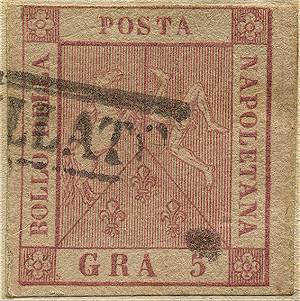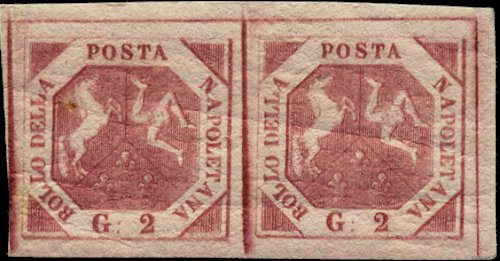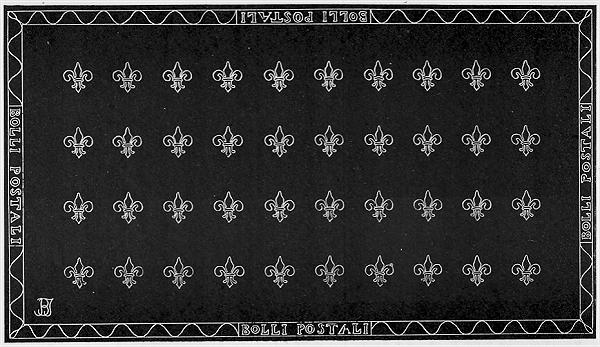|
Half
Grana
|
Pale
pink
|
|
1 Grana
|
Carmine
|
|
2 Grana
|
Pale
pink
|
|
5 Grana
|
Brownish
pink
|
|
10 Grana
|
Brownish
pink
|
|
20 Grana
|
Brownish
pink
|
|
50 Grana
|
Brownish
pink
|
The selected subject was the Two Sicilies coat of arms. In the center of
each stamp the is the coat of arms, divided in three parts; to the left a
rampant horse facing right (Naples emblem), to the right the Trinacria with
three legs (Sicily emblem) and at the bottom three lilies (Borboni emblem).
The background is full of vertical thin lines, around there are frames different
for the various values; round for the Half Grana, squared for the 1 Grana,
octagonal for the 2 Grana, rectangular for the 5 Grana, esagonal for the 10
Grana, of rhombus shape for the 20 Grana and oval for the 50 Grana. To be
noticed how for all the values the upper side and the right side of these
internal frames are much thicker than the other two (in the half Grana and
in the 50 Grana is thicker the left half respectively of the circle and of
the oval). All around there is a double frame of the same shape as the one
enclosing the coat of arms, with the label (from left) "BOLLO DELLA"
- "POSTA" - "NAPOLETANA" and, under it, the value indication
with "G:" for the Half, the 2, the10 and the 50 Grana and "GRA"
for the remaining values. The Mezzo, 2, 10 and 50 Grana are enclosed in a
squared frame forming 4 triangles on the corners, with vertical fine lines;
the1 and the 5 Grana have only 4 ornamental decorations on the corners, while
the 20 Grana does have 4 ornaments of floreal motif on a background of vertical
lines. The most external stamp frame is thicker at the bottom and at right
than at top and at the left. exactly the opposite of that, as already said,
is happening on the internal frame around the coat of arms!
So, stamps of shape and details different for each value. Common only the
choice of the color, always pinkish, a choice not so well done, probably made
to avoid the possibility of compose unwelcome colors with the postage. The
shade very pale leaves often barely to catch a glimpse of the stamp drawing.
Only in rare cases is possible to see perfectly the engraving details (Fig.
1).

Fig. 1: 5 Grana of the 1st
table with engraving exceptionally sharp
The tool engraving is made by Giuseppe Masini, after the Juvara (author of
the Sicily stamps) refusal for the amount of 330 Ducati.
The printing method was the calcographic one, under the responsibility of
the Masini himself, substituted later on by Gaetano De Masa (who dies and
was followed by his son) because Masini was resulted too expensive. The stamps
were printed in sheets of 200 pieces, in two groups side by side of 100 pieces
each, separated by inter-space of a bit less than 1 centimeter. The printing
composition of some value was surrounded by a typographic thin blade distant
few millimeters from the margin: that thin blade is present in the Mezzo Grana
(2nd plate), 1 Grana (2nd plate), 2 Grana (3rd plate), 5 Grana (2nd plate),
10 Grana (2nd plate) and in the 20 Grana (2nd plate) - Fig. 2 -

Fig. 2: couple of the upper
sheet right corner with very evident
external printing frame thin blade mark (upper and to the right)
The hand made paper was provided by the "Bonaventura Tajani" paper mill from Salerno. It was watermarked with 40 borbonic lilies (4 rows of 10) and had around the label "BOLLI POSTALI" enclosed in a double rectangular frame. In the lower left corner there was the label "BT", initials of the manufacturer of the paper (Fig. 3). The stamps that show the complete monogram (that can be found in slightly different versions) are quite rare.

Fig. 3: the stamp watermark
(from "I francobolli del Regno di Napoli" of E. Diena, 1932)
The paper was not uniform
but varied quite a lot in thickness, from very thin and semi-transparent (not
common) to very thick, almost thin cardboard; different was also the manufacturing:
flat, porous, trellis like etc.. Because the distance between the lilies is
somehow large, it is possible to find parts without watermark; the watermark
presents itself in different ways because the sheets were not placed under
the press always in the same direction.
To print the stamps 14 plates have been used; some of them in copper, some
in steel, according to the following scheme:
|
Half
Grana
|
2
plates
|
|
1 Grana
|
2
plates
|
|
2 Grana
|
3
plates
|
|
5 Grana
|
2
plates
|
|
10 Grana
|
2
plates
|
|
20 Grana
|
2
plates
|
|
50 Grana
|
1
plate
|
Each plate is identifiable
from the others by some detail that are analyzed singularly in the cards of
the various stamps. The color shades were not constant, even for the use of
inks of different composition to the point that it is possible to find samples
with quite different shades from each other.
Between the more known varieties there are the multiple engraving, double
printings, front-back printings, and couples misaligned.
Also some engraving variety is known, as incomplete corners, missing characters,
thin blades marks etc..
To be outlines how several values of this issue have been widely forged to
cheat the postal Administration: of some of them are more common the forgeries
than the originals. (for instance the 20 Grana). In the "Going Deep"
section some of these are described.
These stamps were valid up to October 1861 (but samples used after this date
do exist). The quantities printed are known and they are:
|
Half
Grana
|
2.009.800
|
|
1 Grana
|
2.825.000
|
|
2 Grana
|
9.193.000
|
|
5 Grana
|
811.200
|
|
10 Grana
|
300.400
|
|
20 Grana
|
175.000
|
|
50 Grana
|
46.000
|
One last curiosity
that is worth to mention is the presence in each value of a secret sign introduced
by Masini; each stamp, in fact, presents engraved one character. By putting
these letters together we obtain the label "G.MASINI", initial of
the name and the full last name of the engraver: it is the unique case in
the world wide philatelic panorama of all times.
I give you here below the detail of each value, by putting in evidence the
position where the letter is inserted, clarifying also that often the sign
is not visible or is partially visible (Fig. 4).
 |
G.
|
 |
M
|
 |
A
|
 |
S
|
 |
I
|
 |
N
|
 |
I
|